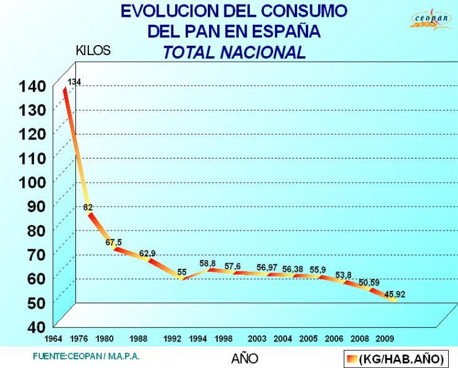After three decades of vague and confusing regulations, the Spanish Council of Ministers has finally approved a set of new updated regulations that puts an end to this situation.
The new regulations published in the Spanish official gazette (BOE) address basic issues such as the definition of what is considered bread or what requirements a product must meet to be marketed as whole meal, artisan, firewood-baked or starter dough. Currently, we purchase bread labeled 100% whole meal that actually isn’t in most cases. New regulations are putting an end to this scam.
Tania Mesa – Director of Neolife’s Nutrition and Nursing Unit
Alejandro Monzó- Neolife Nutrition and Nursing Unit
The new regulations will serve to introduce changes that bring greater quality and protection to consumers
In 1964, Spaniards consumed about 134 kg of bread per person annually. That figure has been declining to 46 kilos in 2009 (Figure 1). At present, we consume five times less bread than 50 years ago; however, the obesity rate has tripled (1).

According to the Ministry’s most recent data from 2018, average yearly consumption per person was 31.77 kilos. Spanish households allocated 5.09% of their budget for food and beverages at home to the purchase of bread. Thus, the annual expenditure per person was 76.13 euros. By types of bread, the most consumed is fresh/frozen bread (80.7%), versus industrial bread (long-lasting dry bread that made up 19.3% of the consumption) (2).
By definition, whole meal bread is made from flours that have not been refined and that contain three parts of the cereal, including the germ and the bran, intact. According to a study by the journal British Journal of Medicine, consumption of whole grains has been shown to play a beneficial role in the prevention of cardiovascular disease, cancer and mortality for all other reasons, reducing the likelihood of suffering from these diseases by 17%. In addition, the authors point out that the additional evidence of this new study backs the importance of consuming more whole grains to reduce the risk of chronic diseases and premature death (3).
Unfortunately, many of the breads we find in supermarkets and establishments labeled as “whole meal” or “contains high fiber content” are basically refined flours seasoned with wheat bran to be able to label products as whole meal. White bread is composed of starch, a polysaccharide that has undergone a fermentation process and that our body rapidly transforms into sugar. There are studies that show how they are fast-absorption carbohydrates, which produce an insulin peak, lack satiating power and are directly linked with the risk of being overweight and obese (4.5).
After a thirty-year legal vacuum around the issue, the new regulations are putting an end to this fraud. The Spanish Agency for Consumer Affairs, Food Safety and Nutrition (AECOSAN) established a series of food labeling guidelines that the food industry must comply with (6). However, in recent years the industry has used this legislation to label breads as whole meal that are not or not in the required amount. Because of this consumers until now have bought breads that are “100% natural”, made with “starter dough” or are “artisan”, as well as those called “multi cereal”, which actually have the minimum percentages of whole meal flours, a situation that is detrimental for public health.
Given the importance of this issue and in response to consumers, the new regulations introduce a series of changes on July 1, 2019 that will ensure greater nutritional quality and consumer protection. In particular, the new regulation includes (7):
1. Raw materials and other ingredients:
All raw materials, ingredients and additives used to make bread must comply with the provisions:
- Basic raw materials: flour, water, baking yeast or starter dough and salt.
- Common bread ingredients: Bran, semolina, groats and whole grains, only in whole meal bread.
The regulations also indicate the incorporation of the following ingredients into the dough, in addition to those indicated for common bread.
- Dry or moist wheat gluten.
- Whole milk, concentrated, condensed, powdered, totally or partially skimmed, or whey powder.
- Eggs and egg products.
- Grain or seed meal from non-cereal plants.
- Malt flour or malt extract, edible sugars or honey.
- Fats and edible oils.
- Raisins, fruits or other vegetables, prepared or seasoned.
2. The definition of whole meal bread and whole grain bread:
The regulations establish a definition of whole meal bread that refers to bread that is prepared exclusively with whole meal or whole grain flour, regardless of the type of cereal. This will clear up any confusion among consumers.
3. The definition of artisan and wood fire baked:
Bread will be considered artisan when it meets the following conditions: in the baking process the human factor must prevail over the mechanical; the dough must undergo a bulk fermentation process; the bread may not be mass-produced; the baking process will be overseen by a master baker or artisan with demonstrated experience. On the other hand, mentions of wood fire or wood oven baked bread may only be used for breads baked entirely in an oven that uses firewood as fuel.
4. The definition of bread made from starter dough:
Starter dough is the active dough composed of wheat or other cereal flour, or a mix of both, and water, with or without adding salt, subjected to a longer fermentation (over 8 hours) whose function is to ensure the fermentation of the dough. It also influences the characteristics of the bread, as it provides aromas from lactic acid bacteria and a more uniform consistency.
5. VAT reduction of whole meal bread to 4%:
All cereal-type breads, either white or whole meal, and those low in salt will fall under the category of common bread (currently, it is included in the category of special bread) and, therefore, their VAT is reduced from 10% to 4%.
6. Maximum limit for salt:
The new bread regulations establish 1.31 grams of salt per 100 grams of bread as the maximum amount of salt in common bread.
7. Elimination of the maximum moisture limit in bread:
The aim is to improve the competitiveness of the sector and support innovation in the technical field, eliminating maximum humidity limits to allow a greater variety of products.
8. Marketing of bread at the point of sale:
Common bread can only be sold within 24 hours after being baked. In exceptional cases common bread can be sold after that time, provided that the stocks of this type of bread are properly separated at the point of sale and it is clearly indicated that they have been baked over 24 hours ago using signs on the display cases or shelves where the bread is stored and provided that the consumer is verbally informed of such circumstance at the same time.
In short, existing restrictions on previous regulations are eliminated and concepts are clarified for consumers.
Our recommendation is clear, and that is to always opt for whole grains due to their proven benefits for our health. Bread has been an important part of traditional diets in many countries throughout the world. But we recommend avoiding white bread in your diet for the following reasons:
- It’s linked to excess body weight and obesity.
- It’s not an essential food in our diet.
- It’s associated with cardiovascular problems.
- At the nutritional level, it is very poor in nutrient density and high in calories.
At Neolife, we want our patients to have the most up-to-date information when it comes to food. Because eating well starts with buying well. A healthy and balanced diet has proven to be a guarantee in disease prevention and a higher quality of life.
BIBLIOGRAPHY
(1) Revenga, J. (2019). “Un nuevo pan para el mundo (y viceversa)”. URL: https://juanrevenga.com/2019/04/un-nuevo-pan-para-el-mundo-y-viceversa/
(2) (2018). “El gobierno aprueba la nueva norma de calidad del pan”. Ministry of Agriculture, Fisheries and Food. URL: https://www.mapa.gob.es/es/prensa/ultimas-noticias/-el-gobierno-aprueba-la-nueva-norma-de-calidad-del-pan-/tcm:30-508466
(3) Dagfinn A. et al (2016). “Whole grain consumption and Risk of cardiovascular disease, cancer, and all cause and cause specific mortality: systematic review and dose-response meta-analysis of prospective studies”. BMJ, 353:i2716.
URL: https://www.bmj.com/content/353/bmj.i2716
(4) Bautista-Castaño, I. at al (2013). “Changes in bread consumption and 4-year changes in adiposity in Spanish subjects at high cardiovascular risk”. Br J Nutr. Vol. 110(2):337-346.
URL: https://www.ncbi.nlm.nih.gov/pubmed/23199451
(5) De la Fuente-Arrillaga, C. at al (2014). “Glycemic load, glycemic index, bread and incidence of overweight/obesity in a Mediterranean cohort: the SUN project”. BMC Public Health, 14:1091.
URL: https://www.ncbi.nlm.nih.gov/pubmed/25335643
(6) (2019). “Declaraciones nutricionales autorizadas en el anexo del Reglamento (CE) Nº 1924/2006”. Ministry of health, consumer affairs and social welfare.
(7) (2019). “Real Decreto 308/2019, de 26 de Abril, por el que se aprueba la norma de calidad para el pan”.
URL: https://www.boe.es/diario_boe/txt.php?id=BOE-A-2019-6994
